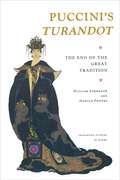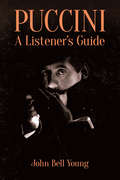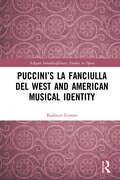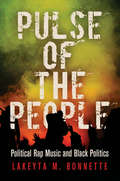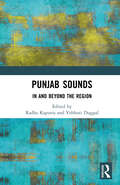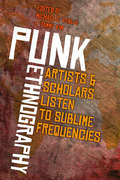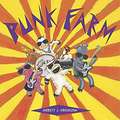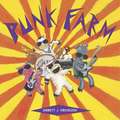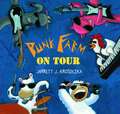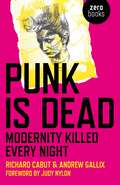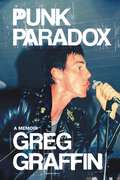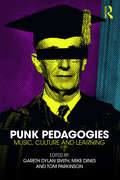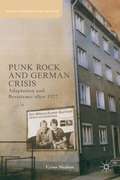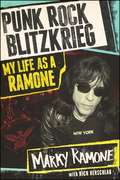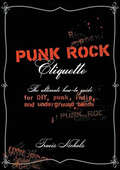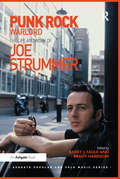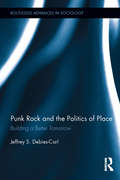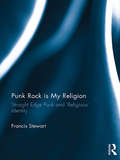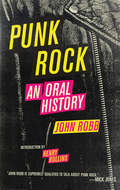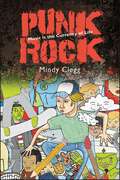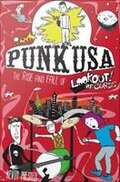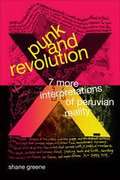- Table View
- List View
Puccini's Turandot: The End of the Great Tradition (Princeton Studies in Opera #30)
by William Ashbrook Harold PowersUnfinished at Puccini's death in 1924, Turandot was not only his most ambitious work, but it became the last Italian opera to enter the international repertory. In this colorful study two renowned music scholars demonstrate that this work, despite the modern climate in which it was written, was a fitting finale for the centuries-old Great Tradition of Italian opera. Here they provide concrete instances of how a listener might encounter the dramatic and musical structures of Turandot in light of the Italian melodramma, and firmly establish Puccini's last work within the tradition of Rossini, Bellini, Donizetti, and Verdi. In a summary of the sounds, sights, and symbolism of Turandot, the authors touch on earlier treatments of the subject, outline the conception, birth, and reception of the work, and analyze its coordinated dramatic and musical design. Showing how the evolution of the libretto documents Puccini's reversion to large musical forms typical of the Great Tradition in the late nineteenth century, they give particular attention to his use of contrasting Romantic, modernist, and two kinds of orientalist coloration in the general musical structure. They suggest that Puccini's inability to complete the opera resulted mainly from inadequate dramatic buildup for Turandot's last-minute change of heart combined with an overly successful treatment of the secondary character.
Puccini: A Listener's Guide (Unlocking The Masters Ser.)
by John Bell YoungGiacomo Puccini (1858-1924) began his career at the end of the Romantic period and his death signaled the end of the last major age of Italian opera. During his lifetime and in posterity, the composer's popularity surpassed that of his peers, and three of his works -- La bohéme, Tosca, and Madama Butterfly -- rank among the twenty-first century's ten most-performed operas. With their enchanting melodies, exotic subjects, and realistic plots, Puccini's operas continue to speak to the minds and hearts of listeners. This comprehensive exploration of Puccini's most beloved operas presents concise and entertaining overviews of the composer's works. In addition to exploring the poignant stories that inspired the operas, the guide elaborates on their musical and dramatic content. Part musical analysis and part interpretation, this book is above all a personal appreciation. In addition to offering an ideal companion for opera devotees, the accessible treatment forms an excellent introduction for novices.
Puccini’s La fanciulla del West and American Musical Identity (Ashgate Interdisciplinary Studies in Opera)
by Kathryn M. FentonOn 10 December 1910, Giacomo Puccini’s seventh opera, La fanciulla del West, had its premiere before a sold-out audience at New York City’s Metropolitan Opera House. The performance was the Metropolitan Opera Company’s first world premiere by any composer. By all accounts, the premiere was an unambiguous success and the event itself recognized as a major moment in New York cultural history. The initial public opinion matched Puccini’s own evaluation of his opera. He called it "the best he had ever written" and expected it to become as popular as La Bohème. Yet the music reviews tell a different story. Marked by ambivalence, the reviews expose the New York City critics’ struggle to reconcile the opera they expected to see with the one they actually saw, and the opera itself became embroiled in controversy over the essence of musical Americanness and the nativist perception that a uniquely American national opera tradition continued to elude both American- and foreign-born opera composers. This book seeks to account for the differences between Puccini’s own assessments of the opera and those of its first audience. Offering transcriptions of the central reviews and of letters unavailable elsewhere, the book provides a historically informed understanding of La fanciulla del West and the reception of this European work as it intersected with both opera production and consumption in the United States and with the process of American musical identity formation during the very period that Americans actively sought to eradicate European cultural influences. As such, it offers a window into the development of nativism and "cosmopolitan nationalism" in New York City’s musical life during the first decade of the twentieth century.
Pulse of the People
by Lakeyta M. BonnetteHip-Hop music encompasses an extraordinarily diverse range of approaches to politics. Some rap and Hip-Hop artists engage directly with elections and social justice organizations; others may use their platform to call out discrimination, poverty, sexism, racism, police brutality, and other social ills. In Pulse of the People, Lakeyta M. Bonnette illustrates the ways rap music serves as a vehicle for the expression and advancement of the political thoughts of the urban Black community, a population frequently marginalized within American society and alienated from electoral politics. Pulse of the People lays a foundation for the study of political rap music and public opinion research and demonstrates ways in which political attitudes asserted in the music have been transformed into direct action and behavior of constituents. Bonnette examines the history of rap music and its relationship to and extension from other cultural and political vehicles within Black America, presenting criteria for identifying the specific subgenre of music that is political rap. She complements the statistics of rap music exposure with lyrical analysis of rap songs that espouse Black Nationalist and Black Feminist attitudes. Touching on a number of critical moments in American racial politics--including the 2008 and 2012 elections and the cases of the Jena 6, Troy Davis, and Trayvon Martin--Pulse of the People makes a compelling case for the influence of rap music in the political arena and greatly expands our understanding of the ways political ideologies and public opinion are formed.
Punching Nazis: And Other Good Ideas
by Keith Lowell JensenKeith Lowell Jensen thinks you should punch Nazis. In this collection of essays, stories, interviews, and rants, he tells us why. Jensen grew up and into the Sacramento punk music scene in the late eighties and early nineties, where weirdos, LGBTQ folk, feminists, and allies strived to carve out safe community spaces. This scene also attracted a different kind of outsider--white supremacists and Nazi skinheads—making for a politically charged and complicated landscape. In Punching Nazis, he reflects on his experiences with these racist fringe groups that infiltrated the progressive scene that gave rise to bands like Green Day. From unwittingly driving around in a lowrider with a gang called “The Suicidals,” to a night doing stand-up with a clown with an unwanted Swastika tattoo, Jensen brings his brand of subtle, sincere comedy to reflect on the complicated relationship that punk music has with racist skinheads and what we should do about it. In recent times, Americans are surprised to find groups like the Klan, and more recently the "Racial Realists" and the "Alt-Right," are still prominent, and now as they grow increasingly emboldened, it’s intriguing and valuable to hear tales of those who, through the love of punk rock music, have a history of dealing with racist fringe groups.
Punjab Sounds: In and Beyond the Region
by Radha Kapuria Vebhuti DuggalPunjab Sounds nuances our understanding of the region's imbrications with sound. It argues that rather than being territorially bounded, the region only emerges in ‘regioning’, i.e., in words, gestures, objects, and techniques that do the region. Regioning sound reveals the relationship between sound and the region in three interlinked ways: in doing, knowing, and feeling the region through sound.The volume covers several musical genres of the Punjab region, including within its geographical remit the Punjabi diaspora and east and west Punjab. It also provides new understandings of the role that ephemeral cultural expressions, especially music and sound, play in the formulation of Punjabi identity. Featuring contributions from scholars across North America, South Asia, Europe, and the UK, it brings together diverse perspectives. The chapters use a range of different methods, ranging from computational analysis and ethnography to close textual analysis, demonstrating some of the ways in which research on music and sound can be carried out.The chapters will be relevant for anyone working on Punjab’s music, including the Punjabi diaspora, music, and sound in the Global South. Moreover, it will be useful for undergraduate and postgraduate students in the following areas: ethnomusicology, cultural studies, film studies, music studies, South Asian studies, Punjab studies, history, and sound studies, among others.
Punk Aesthetics and New Folk: Way Down the Old Plank Road (Ashgate Popular and Folk Music Series)
by John EncarnacaoJoanna Newsom, Will Oldham (a.k.a. 'Bonnie Prince Billy'), and Devendra Banhart are perhaps the best known of a generation of independent artists who use elements of folk music in contexts that are far from traditional. These (and other) so called ’new folk’ artists challenge our notions of 'finished product' through their recordings, intrinsically guided by practices and rhetoric inherited from punk. This book traces a fractured trajectory that includes Harry Smith's Anthology of American Folk Music, Bob Dylan, psych-folk of the sixties (from Vashti Bunyan to John Fahey), lo-fi and outsider recordings (from Captain Beefheart and The Residents to Jandek, Daniel Johnston and Smog), and recent experimental folk (Animal Collective, Six Organs of Admittance, Charalambides) to contextualise the first substantial consideration of new folk. In the process, Encarnacao reviews the literature on folk and punk to argue that tropes of authenticity, though constructions, carry considerable power in the creation and reception of recorded works. New approaches to music require new analytical tools, and through the analysis of some 50 albums, Encarnacao introduces the categories of labyrinth, immersive and montage forms. This book makes a compelling argument for a reconsideration of popular music history that highlights the eternal compulsion for spontaneous, imperfect and performative recorded artefacts.
Punk Ethnography: Artists & Scholars Listen to Sublime Frequencies
by Michael E. Veal E. Tammy KimThis ground-breaking case study examines record production as ethnographic work. Since its founding in 2003, Seattle-based record label Sublime Frequencies has produced world music recordings that have been received as radical, sometimes problematic critiques of the practices of sound ethnography. Founded by punk rocker brothers Alan and Richard Bishop, along with filmmaker Hisham Mayet, the label's releases encompass collagist sound travelogues; individual artist compilations; national, regional and genre surveys; and DVDs--all designed in a distinctive graphic style recalling the DIY aesthetic of punk and indie rock. Sublime Frequencies' producers position themselves as heirs to canonical ethnographic labels such as Folkways, Nonesuch, and Musique du Monde, but their aesthetic and philosophical roots in punk, indie rock, and experimental music effectively distinguish their work from more conventional ethnographic norms. Situated at the intersection of ethnomusicology, sound studies, cultural anthropology, and popular music studies, the essays in this volume explore the issues surrounding the label--including appropriation and intellectual property--while providing critical commentary and charting the impact of the label through listener interviews.
Punk Farm
by Jarrett J. KrosoczkaAfter a long day of work, Farmer Joe goes home to bed. But meanwhile, back at the barn . . . Cow sets up her drums. Pig plugs in his amp. Goat tunes his bass. Chicken sets up her keyboards. And Sheep checks the microphone. They are Punk Farm and tonight they're ready to ROCK! With adorable farm animals - and a surprise tribute to Old MacDonald - this rollicking tale is sure to have kids cheering--and singing--along. From the Hardcover edition.
Punk Farm (Punk Farm Books)
by Jarrett J. KrosoczkaAfter a long day of work, Farmer Joe goes home to bed. But meanwhile, back at the barn . . .Cow sets up her drums.Pig plugs in his amp.Goat tunes his bass.Chicken sets up her keyboards.And Sheep checks the microphone.They are Punk Farm and tonight they're ready to ROCK! With adorable farm animals - and a surprise tribute to Old MacDonald - this rollicking tale is sure to have kids cheering--and singing--along.From the Hardcover edition.
Punk Farm on Tour (Punk Farm Books)
by Jarrett J. KrosoczkaFARMER JOE IS heading off to a Tractor Society Conference in Reno. But meanwhile, back at the farm . . .. . . Cow, Sheep, Pig, Goat, and Chicken are getting ready to rock across the U.S.A. as they set out on a Punk Farm tour! Only, their beat-up old tour van is threatening to ruin their plans. Can the wheels on the van go round and round all the way from Maine to Colorado?This rollicking sequel to Punk Farm will have kids cheering along as their favorite rock star farm animals take the nation by storm!From the Hardcover edition.
Punk Is Dead: Modernity Killed Every Night
by Andrew Gallix Richard CabutThis original collection of insight, analysis and conversation charts the course of punk from its underground origins, when it was an un-formed and utterly alluring near-secret, through its rapid development. Punk is Dead: Modernity Killed Every Night takes in sex, style, politics and philosophy, filtered through punk experience, while believing in the ruins of memory, to explore a past whose essence is always elusive.
Punk Paradox: A Memoir
by Greg GraffinFrom the legendary singer-songwriter of Bad Religion comes a historical memoir and cultural criticism of punk rock&’s evolution. Greg Graffin is the lead vocalist and songwriter of Bad Religion, recently described as &“America's most significant punk band.&” Since its inception in Los Angeles in 1980, Bad Religion has produced 18 studio albums, become a long-running global touring powerhouse, and has established a durable legacy as one of the most influential punk rock bands of all time. Punk Paradox is Graffin's life narrative before and during L.A. punk's early years, detailing his observations on the genre's explosive growth and his band's steady rise in importance. The book begins by exploring Graffin&’s Midwestern roots and his life-changing move to Southern California in the mid-&’70s. Swept up into the burgeoning punk scene in the exhilarating and often-violent streets of Los Angeles, Graffin and his friends formed Bad Religion, built a fanbase, and became a touring institution. All these activities took place in parallel with Graffin's never ceasing quest for intellectual enlightenment. Despite the demands of global tours, recording sessions, and dedication to songwriting, the author also balanced a budding academic career. In so doing, he managed to reconcile an improbable double-life as an iconic punk rock front man and University Lecturer in evolution. Graffin&’s unique experiences mirror the paradoxical elements that define the punk genre—the pop influence, the quest for society&’s betterment, music&’s unifying power—all of which are prime ingredients in its surprising endurance. Fittingly, this book argues against the traditional narrative of the popular perception of punk. As Bad Religion changed from year to year, the spirit of punk—and its sonic significance—lived on while Graffin was ever willing to challenge convention, debunk mythology, and liberate listeners from the chains of indoctrination. As insightful as it is exciting, this thought-provoking memoir provides both a fly on the wall history of the punk scene and astute commentary on its endurance and evolution.
Punk Pedagogies: Music, Culture and Learning
by Gareth Dylan Smith Mike Dines Tom ParkinsonPunk Pedagogies: Music, Culture and Learning brings together a collection of international authors to explore the possibilities, practices and implications that emerge from the union of punk and pedagogy. The punk ethos—a notoriously evasive and multifaceted beast—offers unique applications in music education and beyond, and this volume presents a breadth of interdisciplinary perspectives to challenge current thinking on how, why and where the subculture influences teaching and learning. As (punk) educators and artists, contributing authors grapple with punk’s historicity, its pervasiveness, its (dis)functionality and its messiness, making Punk Pedagogies relevant and motivating to both instructors and students with proven pedagogical practices.
Punk Rock And German Crisis
by Cyrus Shahan1977 is usually associated with West German terrorism, but it witnessed another cultural watershed: punk music. A new reckoning with the legacy of political and aesthetic spaces, this book argues the centrality of punk music for understanding crises of state and terrorist violence, American racism and German fascism, and aesthetic production.
Punk Rock Blitzkrieg
by Marky Ramone Richard HerschlagThe inside story behind one of the most revered bands in music history during the early days of punk rock in New York, from legendary drummer Marky Ramone.Rolling Stone ranked the Ramones at #26 on its list of the "100 Greatest Artists of All Time." They received a Grammy Lifetime Achievement Award in 2011 and were inducted into the Rock and Roll Hall of Fame in 2002. And Marky Ramone played a major part in this success--his "blitzkrieg" style of drumming drove the sound the Ramones pioneered. Now, fans can get the inside story. Before he joined the Ramones, Marc Bell was already a name in the New York music scene. But when he joined three other tough misfits, he became Marky Ramone, and the rhythm that came to epitomize punk was born. Having outlived his bandmates, Marky is the only person who can share the secrets and stories of the Ramones' improbable rise from obtuse beginnings to induction into the Rock and Roll Hall of Fame. But it wasn't all good times and hit songs, and Marky doesn't shy away from discussing his own struggles, including the addiction to alcohol that led him to be temporarily kicked out of the band. From the cult film Rock 'n' Roll High School through "I Wanna Be Sedated" through his own struggle with alcoholism, Marky Ramone sets the record straight, painting an unflinching picture of the dysfunction behind the band that changed a generation. With exclusive behind-the-scenes photos, Punk Rock Blitzkrieg is both a cultural history of punk and a stirring story that millions of fans have been waiting for.
Punk Rock Entrepreneur: Running a Business without Losing Your Values
by Caroline MooreDo you have an idea for something that you want to share with the world but don't know where to start? Want to make a living without selling your soul? Have a business plan but can't afford to buy anything up front? This book is for you.Punk Rock Entrepreneur is a guide to launching your own business using DIY methods that allow you to begin from wherever you are, right now. Caroline Moore talks (and illustrates!) you through the why and how of business operations that she learned over years booking bands, organizing fests, sleeping on couches, and making a little go a long way. Engaging stories and illustrations show you the ropes, from building a network and working distribution channels to the value of community and being authentic.With first hand accounts from touring bands and small business owners, this book gives you the inspiration and down-to-earth advice you'll need to get started working for yourself.
Punk Rock Etiquette: The Ultimate How-to Guide for DIY, Punk, Indie, and Underground Bands
by Travis NicholsLooking to start an underground band? Don't make a move until you've read this book! So you KNOW you are destined to rock... well you're in luck -- all you need is this book! (Please note musical talent, bandmates, a car for touring, and an uncle who owns a record label might also help.) An original blend of nonfiction how-to's about all things DIY rock created by an indie-circuit veteran with a knack for hysterical snark, PUNK ROCK ETIQUETTE teaches you everything from how to pick your bandmates and choose a name (Never deliberately misspell your band's name. C how lame it lookz?), to detailed guides on screenprinting your own merch, and interviews and advice from studio owners about the do's and don'ts of recording. PUNK ROCK ETIQUETTE is an unfiltered peek backstage that will appeal to aspiring musicians and anyone who's curious about what goes on in the hours between the last chord and the next big show.
Punk Rock Warlord: the Life and Work of Joe Strummer (Ashgate Popular and Folk Music Series)
by Barry J. Faulk Brady HarrisonPunk Rock Warlord explores the relevance of Joe Strummer within the continuing legacies of both punk rock and progressive politics. It is aimed at scholars and general readers interested in The Clash, punk culture, and the intersections between pop music and politics, on both sides of the Atlantic. Contributors to the collection represent a wide range of disciplines, including history, sociology, musicology, and literature; their work examines all phases of Strummer’s career, from his early days as ’Woody’ the busker to the whirlwind years as front man for The Clash, to the ’wilderness years’ and Strummer’s final days with the Mescaleros. Punk Rock Warlord offers an engaging survey of its subject, while at the same time challenging some of the historical narratives that have been constructed around Strummer the Punk Icon. The essays in Punk Rock Warlord address issues including John Graham Mellor’s self-fashioning as ’Joe Strummer, rock revolutionary’; critical and media constructions of punk; and the singer’s complicated and changing relationship to feminism and anti-racist politics. These diverse essays nevertheless cohere around the claim that Strummer’s look, style, and musical repertoire are so rooted in both English and American cultures that he cannot finally be extricated from either.
Punk Rock and the Politics of Place: Building a Better Tomorrow (Routledge Advances in Sociology)
by Jeffrey S. Debies-CarlThis book is an ethnographic investigation of punk subculture as well as a treatise on the importance of place: a location with both physical form and cultural meaning. Rather than examining punk as a "sound" or a "style" as many previous works have done, it investigates the places that the subculture occupies and the cultural practices tied to those spaces. Since social groups need spaces of their own to practice their way of life, this work relates punk values and practices to the forms of their built environments. As not all social groups have an equal ability to secure their own spaces, the book also explores the strategies punks use to maintain space and what happens when they fail to do so.
Punk Rock is My Religion: Straight Edge Punk and 'Religious' Identity
by Francis StewartAs religion has retreated from its position and role of being the glue that holds society together, something must take its place. Utilising a focused and detailed study of Straight Edge punk (a subset of punk in which adherents abstain from drugs, alcohol and casual sex) Punk Rock is My Religion argues that traditional modes of religious behaviours and affiliations are being rejected in favour of key ideals located within a variety of spaces and experiences, including popular culture. Engaging with questions of identity construction through concepts such as authenticity, community, symbolism and music, this book furthers the debate on what we mean by the concepts of ‘religion’ and ‘secular’. Provocatively exploring the notion of salvation, redemption, forgiveness and faith through a Straight Edge lens, it suggests that while the study of religion as an abstraction is doomed to a simplistic repetition of dominant paradigms, being willing to examine religion as a lived experience reveals the utility of a broader and more nuanced approach.
Punk Rock: An Oral History
by John Robb Lars FredriksenVibrant and volatile, the punk scene left an extraordinary legacy of music and cultural change, and this work talks to those who cultivated the movement, weaving together their accounts to create a raw and unprecedented oral history of punk in the United Kingdom. From the Clash, Crass, Henry Rollins, and John Lydon to the Sex Pistols, the Stranglers, and the Buzzcocks, this reference features more than 150 interviews that encapsulate the most thrilling wave of rock and roll pop culture ever seen. Ranging from its widely debated roots in the late 1960s to its enduring influence on modern bands, fashion, and culture, this history brings to life the energy and anarchy as no other book has done.
Punk Rock: Music Is the Currency of Life
by Mindy CleggPunk Rock examines the history of punk rock in its totality. Punk became a way of thinking about the role of culture and community in modern life. Punks forged real alternatives to producing popular music and built community around their music. This punk counterpublic, forged in the late Cold War period, spanned the globe and has provided a viable cultural alternative to alienated young people over the years. This book starts with the rise of modernity and places the emergence of punk as a musical subculture into that longer historical narrative. It also reveals how punk itself became a contested terrain, as participants sought to imbue the production of music with greater meaning. It highlights all styles of punk and its wide variety of creators around the world, including from the LGBTQ+, feminist, and alternative communities. Punk was and remains a transnational phenomenon that influences music production and shapes our understanding of culture’s role in community building.
Punk USA
by Kevin PrestedThrough hundreds of exclusive and original interviews, Punk USA documents an empire that was built overnight as Lookout sold millions of records and rode the wave of the second coming of punk rock until it all came crashing down. In 1987, Lawrence Livermore founded independent punk label Lookout Records to release records by his band The Lookouts. Forming a partnership with David Hayes, the label released some of the most influential recordings from California's East Bay punk scene, including a then-teenaged Green Day. Originally operating out of a bedroom, Lookout created "The East Bay Punk sound," with bands such as Crimpshrine, Operation Ivy, The Mr. T Experience, and many more. The label helped to pave the way for future punk upstarts and as Lookout grew, young punk entrepreneurs used the label as a blueprint to try their hand at record pressing. As punk broke nationally in the mid 90s the label went from indie outfit to having more money than it knew how to manage.
Punk and Revolution: Seven More Interpretations of Peruvian Reality
by Shane GreeneIn Punk and Revolution Shane Greene radically uproots punk from its iconic place in First World urban culture, Anglo popular music, and the Euro-American avant-garde, situating it instead as a crucial element in Peru's culture of subversive militancy and political violence. Inspired by José Carlos Mariátegui's Seven Interpretive Essays on Peruvian Reality, Greene explores punk's political aspirations and subcultural possibilities while complicating the dominant narratives of the war between the Shining Path and the Peruvian state. In these seven essays, Greene experiments with style and content, bends the ethnographic genre, and juxtaposes the textual and visual. He theorizes punk in Lima as a mode of aesthetic and material underproduction, rants at canonical cultural studies for its failure to acknowledge punk's potential for generating revolutionary politics, and uncovers the intersections of gender, ethnicity, class, and authenticity in the Lima punk scene. Following the theoretical interventions of Debord, Benjamin, and Bakhtin, Greene fundamentally redefines how we might think about the creative contours of punk subculture and the politics of anarchist praxis.
